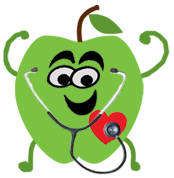Blood Pressure
What is it?
 Blood pressure is how hard your heart has to work to keep blood pumping through your body. Blood pressure readings are made up of two numbers — Systolic (top number, which is the pressure as your heart beats) and Diastolic (bottom number, the pressure as your heart relaxes). Together, they provide a glimpse of what is happening inside your body. For example, if you’ve ever tried to block part of a hose or cover part of a faucet, you may have noticed how the water comes out lot faster from the area left uncovered. This is just like blood pressure. Blood pressure provides an early indication that something is wrong if our blood vessels develop blockages.
Blood pressure is how hard your heart has to work to keep blood pumping through your body. Blood pressure readings are made up of two numbers — Systolic (top number, which is the pressure as your heart beats) and Diastolic (bottom number, the pressure as your heart relaxes). Together, they provide a glimpse of what is happening inside your body. For example, if you’ve ever tried to block part of a hose or cover part of a faucet, you may have noticed how the water comes out lot faster from the area left uncovered. This is just like blood pressure. Blood pressure provides an early indication that something is wrong if our blood vessels develop blockages.
How is it measured?
Systolic and diastolic blood pressure measurements calculated by an automated cuff. Since August 2012, we have used an automated machine with unisize automated cuff from A&D Medical. Prior to that, we used an Omron automated blood pressure machine with cuff size (child, medium, large, extra large) selected by the volunteer depending on arm size.
This station is available for the following audience and takes approximately:
- Adults (English, Spanish, Chinese, Vietnamese and Korean) – Takes about 1-2 minutes
- Kids (English, Spanish, Chinese, Vietnamese and Korean) – Takes about 1-2 minutes
How we determined the categories?
Adults: Uses American Heart Association’s cut points
Adolescents: Blood Pressure varies based on height in adolescents. For feedback at events, we use adolescent cutpoints derived from the 50th percentile for height and the 90th percentile for blood pressure based on age (years and 11 months). These numbers come from the US Department of Health & Human Services; National Heart Lung and Blood Institute – Blood Pressure Tables for Children and Adolescents from the Fourth Report on the Diagnosis, Evaluation, and Treatment of High Blood Pressure in Children and Adolescents (2004)
Where to get more information…
Most of our information come from the following two sources which have excellent resources for all reading levels:
The American Heart Association’s blood pressure page
National Institutes of Health’s National Heart, Lung and Blood Institute blood pressure page
Research Bibliography
US Department of Health & Human Services; National Heart Lung and Blood Institute – Blood Pressure Tables for Children and Adolescents from the Fourth Report on the Diagnosis, Evaluation, and Treatment of High Blood Pressure in Children and Adolescents (2004) http://www.nhlbi.nih.gov/guidelines/hypertension/child_tbl.htm
Explore the Cardiovascular Data



